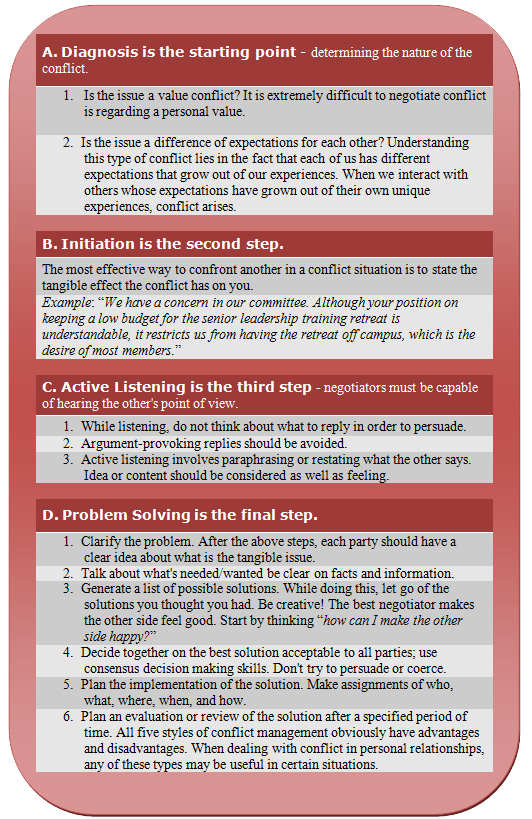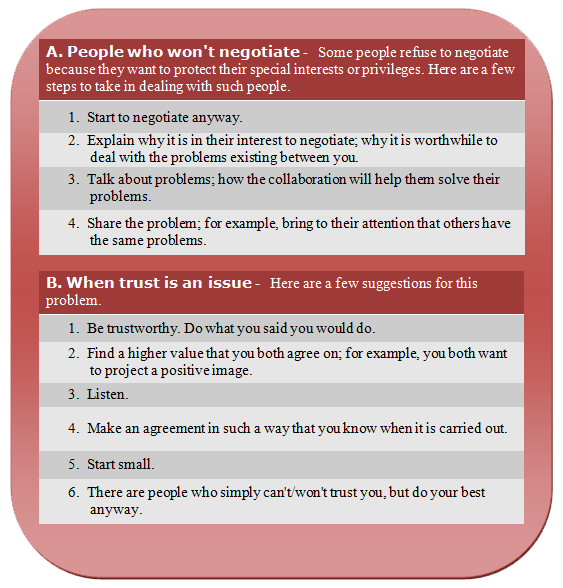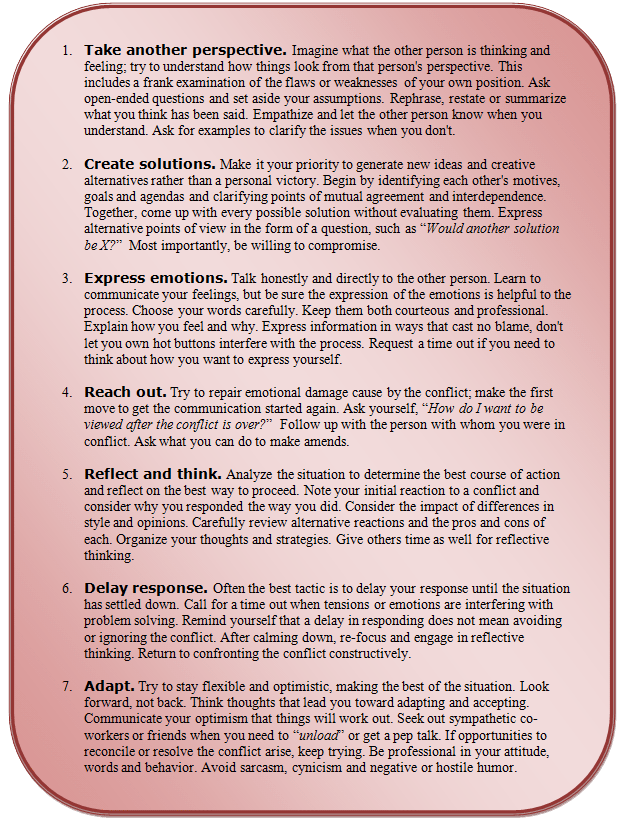CONFLICT MANAGEMENT
Unit Overview
Read and study the following unit. Answer the questions at the end of the unit based on the information that you have learned from the unit.

|
Managing Conflict
Conflict is inevitable in any interpersonal relationship or among members of any group and can be a very positive experience, if managed properly. Why do we shy away from dealing with conflict? Many of us were raised to believe that conflict is something to be avoided, an experience of failure. However, conflict doesn't have to lead to failure, defeat, separation, or termination of individual relationships.We all come to see the world in different ways, and we have different ideas about what's best for us and what's best for our group. It is actually a signal that change is needed and possible. The ability to manage conflict is probably one of the most important social skills individuals can possess.
What's Your Conflict Resolution Style?
Which of the following best describes how you handle conflicts?
- I don't like conflicts, and I try to avoid them. I would rather not be forced into a situation where I feel uncomfortable or under stress. When I do find myself in that kind of situation, I say very little, and I leave as soon as possible.
- To me, conflicts are challenging. They're like contests or competitions – opportunities for me to come up with solutions. I can usually figure out what needs to be done, and I'm usually right.
- When faced with a conflict or even a potential conflict, I tend to back down or give in rather than cause problems. I may not get what I want, but that's a price I'm willing to pay for keeping the peace.
- I want to resolve the conflict as quickly as possible. I give up something I want or need, and I expect the other person to do the same. Then we can both move forward.
- I try to see conflicts from both sides. What do I need? What does the other person need? What are the issues involved? I gather as much information as I can, and I keep the lines of communication open. I look for a solution that meets everyone's needs.
Interpretation
If you chose #1, your conflict resolution style is evader. This is a lose-lose strategy. When one partner avoids a conflict, neither partner has an opportunity to resolve it. Both partners lose. Avoiding - These individuals do not immediately pursue their own concerns or those of the other person if they do not address the conflict. Avoiding might take the form of diplomatically sidestepping an issue, postponing an issue until a better time, or simply withdrawing from a threatening situation.
If you chose #2, your conflict resolution style is fighter. This is a win-lose/lose-win strategy. Either you win and your partner loses, or you lose and your partner wins. It's survival of the fittest. But conflicts are not contests, and this style precludes the possibility of finding a fair solution. Competing – When competing, you only care about winning. There will be a winner and a loser. This process involves resolution through using power and winning by force or coercion. It may take the form of “pulling rank,” brow-beating, or simply outmaneuvering the opposition. The distinguishing feature of the power strategy is that resolution of the problem is unrelated to the relative merits of arguments (e.g., “You will do what I say because I'm your father and no questions asked!”).
If you chose #3, your conflict resolution style is harmonizer. This is a lose-win strategy. You lose because your needs aren't met. Your partners' needs are met, but the partnership suffers because you eventually become resentful and unsatisfied. Accommodating - The opposite of competing. When accommodating, you neglect your own concerns to satisfy the concerns of the other person; there is an element of self-sacrifice in this mode. Accommodating might take the form of selfless generosity or charity, obeying another person's order when one would prefer not to, or yielding to another's point of view.
If you chose #4, your conflict resolution style is compromiser. This is a lose-lose strategy. Both you and your partner give up something you need just to make the conflict “go away.” Invariably, you end up addressing the same issues later. Compromising - The objective is to find some expedient, mutually acceptable solution which partially satisfies both parties. It falls on a middle ground between competing and accommodating. Compromising gives up more than competing but less than accommodating. Likewise, it addresses an issue more directly than avoiding, but doesn't explore it in as much depth as collaborating. Compromising might mean splitting the difference, exchanging concessions, or seeking a quick middle-ground position.
If you chose #5, your conflict resolution style is negotiator. This is a win-win strategy. Both you and your partner have the chance to express your needs and resolve the conflict in a mutually acceptable way. While this strategy may sound simple, it's actually the most difficult to use. It requires each of you to articulate, prioritize, and satisfy your own needs while addressing the other person's needs. Collaborating - The opposite of avoiding. Collaborating involves an attempt to work with the other person to find some solution which fully satisfies the concerns of both. It means digging into an issue to identify the underlying concerns of the two individuals and to find a solution which meets both sets of concerns. This is clearly the most effective approach of conflict management. Specifically it will produce the following results:
- Needs are met on both sides
- Satisfaction
- Mutual respect
- Both parties feel enriched rather than belittled
- Continuing effort of both parties to work together
Four Steps of the Collaborating Approach (Win-Win Negotiation) to Deal With Conflict
 |
The last style, collaboration, however, is highly recommended for dealing with conflict. It results in something satisfactory to both parties. People often feel proud of themselves and feel a sense of personal power when they use this method. It's a sign of integrity and self-confidence when one is able to use this method with patience regardless of how difficult the situation may be.
Two Issues Which You Might Have To Deal With When Confronting A Conflict
 |
Conflict: Constructive or Destructive?
What creates conflict in your family or circle of friends? Different views on values and responsibility? poor relationships or personality clashes? Conflict occurs for many reasons. However, by changing how your respond to conflict, you can reduce its harmful effects and maximize its useful ones.
If it is well managed, conflict can have positive outcomes. Conflict can lead to better decision making, expose key issues, stimulate critical thinking, or fuel creativity and innovation. By learning to increase constructive responses to conflict and reduce destructive ones, you can defuse tensions and find productive solutions to difficult problems.
Constructive Responses
Behaviors that help to build relationships, manage emotions, and accept and resolve conflict are considered constructive responses. They emphasize task-completion and problem solving, creativity and exchange of ideas, and the expression of positive emotions. When constructive behaviors are the norm in a group or organization, typical outcomes include
|

|
Destructive Responses
Destructive responses prolong and inflame conflict and get in the way of productivity. Trying to win no matter what, lack of respect for others, avoiding conflict and negatively expressing emotions are destructive. These behaviors will lead to
 |
|
If your work environment shows the signs of destructive responses, you'll want to identify the behaviors undermining resolution and rein them in. Set new norms and expectations for handling disagreements and begin to develop the skills that lead to more constructive outcomes.
A Positive Response: 7 Ways to Make Conflict Productive
Dealing with conflict is a task many managers struggle with or even avoid. But you can transform disagreement and discord into positive outcomes by learning seven constructive ways to respond to conflict.
 |
Resolving Conflict Constructively and Respectfully
Resolving Contract Constructively and Respectfully PDF
Conflict Resolution
No matter how much you learn about conflict, no matter how excellent your skills become in handling it, no matter how great a master you are at even avoiding it, the truth is you'll never get rid of conflict. Anytime you get together two people who think they're even halfway intelligent, you're bound to have some differences of opinion. But here's good news, too. Even if you can't totally rid yourself of opposition from and between others, there is much that you can learn to do to manage these conflicts.
We grow the most through learning how to work through differences. We learn we can disagree with others, but still like them – or at least respect them. We see the best friendships and the most creative working relationships are those that allow differences of opinion.
The six steps below will increase your ability to work through differences with others in all areas of your life and restore the ability to be a team in the workplace and at home.
1. Preparation
If there is one thing I have learned in my life, it is to try not to speak or to take action out of anger. That's pretty difficult, because like many people, I am most encouraged to give a piece of my mind when I am hot under the collar. Unfortunately, my mind is definitely on hold when emotions take over, and when reason finally returns, I invariably regret having given in to impulse.
Whenever possible, put distance and time between your reaction and action so you can let sanity return to think things through. If there is a way to give both you and the other party time to cool off when tempers flare, do so.
The best way to prepare yourself when you know you are going to meet with someone where emotions will be high is to do a “dump sheet.” Take a legal-size pad of paper and pen and find a place where you can be alone for five to ten minutes (that might be the hardest part). Then write down all your thoughts, feelings, beliefs, concerns, worries, anxieties, emotions, hates, biases, prejudices, nasty words – anything and everything that is on your mind and in your heart at the time. Do not censor anything. It is critical to get it all out on the paper.
Doing a “dump sheet” allows you to move from a subjective place to a position of objectivity. It allows you to see what is really bothering you and why, to see if you are making a mountain out of a molehill, and to see the best strategy you can take with the person to whom you will be talking. Once you have done your “dump sheet,” the best course of action will become clear to you.
2. Clarify the Problem
When you do sit down to discuss differences, it will be to your advantage to state your case briefly, perhaps with documentation, and then ask for the other side of the story. Try as much as possible to suspend all feelings and judgments and give the other person a fair trial in your mind. At this stage, the goal is to get communication going, not to make any final decisions.
Ifyou have a person who is reluctant to open up, ask sincere open-ended questions related to the situation. Good open-ended questions are, “What do you see the problem to be?” or “Your opinion is important; what do you think?” Then sit still and say nothing. Let there be silence. Eventually, they will realize they won't get away with a mere “Yes,” “No,” or “I don't know.”
 Asking questions and being genuinely interested in the other person's feelings about the situation are critical to getting to the root of a problem. But the single most powerful communication tool to use for re-establishing rapport and getting to the truth is to paraphrase. You may not agree with their point of view, but you are really trying to see it from their vantage point. That will encourage them to do the same.
Asking questions and being genuinely interested in the other person's feelings about the situation are critical to getting to the root of a problem. But the single most powerful communication tool to use for re-establishing rapport and getting to the truth is to paraphrase. You may not agree with their point of view, but you are really trying to see it from their vantage point. That will encourage them to do the same.
Study after study shows that summarizing frequently what the other is saying in conflict does more than any other communication skill to promote harmony and reestablish rapport. In fact, when extremely successful sales people were studied closely to see what made them different from the average salesperson, they found that the superior salesperson paraphrased and summarized an average of four times in a seven to eight minute conversation.
3. Seek Areas of Agreement
Once you have gotten all sides of the story, it is now time to see if you and the other party have any areas of agreement. One thing I have learned is to take a big sheet of paper (those legal-size pads really come in handy), put a dividing line down the middle, and together list the issues you agree on and those you don't.
If it is in your interest to promote agreement, then making sure to think of all the possible little things you both agree upon and writing them down, encourages the other person to do the same. Paraphrasing makes others feel they can trust you.
In the “Disagree” column, write down only the main issues. This process has the psychological effect of making the areas of agreement look greater and the areas of disagreement look smaller. It also helps you both to see whether you at least agree on what's important; i.e., if you share common values.
4. Taking Responsibility
If the above three steps occur, taking ownership for how you might have contributed to the problem becomes the natural next step in the process. Most of the time, all parties involved in the discussion contributed to the problem in some small or large way. What do you do if the other person has a poor history of telling the truth or keeps throwing blame? It is important to assert to this person in a professional and clear tone of voice where you see his or her contribution to the problem. Then, take responsibility for your own portion. Finally, reiterate in summary form where you see his or her contribution. If you have gotten this far in the communication process and still get nowhere, then it would be best to end the meeting and try again later. You can also try using a mediator. If the other side seems open to working with you, as soon as you see how you have contributed to the situation, own up. This will often take the other person off the defensive and increase the chances they will own up as well. I have learned if I own up even for something small, such as not communicating clearly enough the importance to me of being on time to staff meetings, the other party may be more willing to admit that they are late because staff meetings are a waste of time. That will allow us to then look at how meetings are not working (and what both of us can do to make them more productive). Taking ownership often means allowing honesty to come to the surface, and it is important not to take it personally. Remember, honesty is best for getting to the real difficulties and moving into problem-solving. Become focused on results and ask, “So, what can we do to resolve the situation?”
5. Finding Solutions
Finding solutions becomes a lot easier once trust and agreement areas have been established. A critical component to re-establishing the ability to work together at this stage is to engage in some form of brainstorming. Unless you have the absolutely perfect solution already at hand, it is a wonderful skill to develop when building trust and camaraderie.
The goal in a conflict resolution session is to find a solution through a combination of both parties' ideas; everyone involved has contributed to the solution, it increases the chances that everyone will buy in and follow it. However, if you feel you must take a firmer guiding role, offer options.
In our society, options make us feel we have a choice, even if they are over small issues. For example, if you and the other person have come to some agreement that involves you doing some follow-up-work, you can say, “Would you like me to get back to you Thursday or Friday?” A simple option, but it increases the spirit of collaboration. Remember, when there have been difficulties, small efforts do make a difference.
You can also use options to show you mean business too. I have seen some fast changes in troublesome individuals who are always bothering everybody once they realize that one of the options is “no job.”
When a solution has been found, it is important to write it down, especially if this is a problem occurring in the workplace. Also do a final summary of what occurred in the meeting together. I am constantly amazed at the number of times people remember the whole situation completely differently from each other, let alone the details. A written record (even if just a few words) and a final mutual summary of what went on will do a lot to prevent problems later on.
Prepare by writing a “dump sheet.” An encouraging word – Now that I've given you all this great information, how would you like a strategy that will be much more fun, has long-term results and will bypass most of the work above? Psychologists see it as one of the most powerful tools for shaping behavior. What is this great invention?
6. Positive Reinforcement
To use positive reinforcement effectively requires a change in how you look at the other persons. Try not to speak out of anger.
Instead of focusing on the things they are doing wrong, start looking for the little things that are steps in the right direction. Then reinforce them. The reinforcement has to be something that will have impact and it should be applied as soon as possible after the positive action occurred. Praise, recognition and being included in decision-making usually have even greater impact than money. Also, once you begin bestowing money, it's hard to take it away. Be creative in coming up with reinforcements.
And if you ever find your ego in danger of becoming inflated, just think of what Napoleon once said to his troops as they prepared for battle. He said, “Men, there is someone wiser than each of us, and that is everyone!”
Understanding Conflict Resolution
Conflict arises from a discord of needs, drives, wishes, and/or demands. Conflict in and of itself is not positive or negative. Rather, it is the response to conflict that transforms it into either a competitive or destructive experience or a constructive challenge offering opportunity for growth. Since conflict is an inevitable part of life, learning how to respond to it constructively is essential. Constructive conflict resolution begins with developing an understanding of conflict and the principles of conflict resolution (see Figure 1).
|
Source: Bodine, R., D. Crawford, and F. Schrumpf. 1994. Creating the Peaceable School: A comprehensive Program for Teaching Conflict Resolution. Champaign, IL: Research Press, Inc., p. 92. Reprinted with permission of the authors and Research Press
Origins Of Conflict
Almost every conflict involves an attempt by the disputants to meet basic needs that, if not satisfied, cause the conflict to persist, even when an agreement is reached about the subject of the dispute.
Basic Psychological Needs
All individuals are motivated by needs. Dr. William Glasser identifies four basic psychological needs that motivate behavior.
-Belonging: Fulfilled by loving, sharing, and cooperating with others -Power: Fulfilled by achieving, accomplishing, and being recognized and respected -Freedom: Fulfilled by making choices -Fun: Fulfilled by laughing and playing |
 |
Conflicts may occur, for example, when two individuals in a relationship have different ideas about how to belong or because one is more concerned with building the relationship and the other with maintaining a sense of freedom. When conflict arises, individuals have essentially two choices: to continue the conflict or to problem-solve. The problem-solving strategies of conflict resolution address needs and create opportunities for those needs to be satisfied. When individuals choose to continue the conflict, no one's basic needs are fulfilled. Basic psychological needs are the root of almost all conflict.
Limited Resources
Conflicts may arise over limited resources. Conflict resolution principles suggest that when limited resources are at issue, individuals' best interests lie in cooperating, not competing. In cooperating, disputants share in the process of problem solving, recognize each other's interests, and create choices. This process usually provides satisfaction because the psychological needs of belonging and power, and perhaps even of freedom and fun, are addressed in the fail allocation of limited resources.
Conflicts over limited resources may not be resolved if basic needs are not addressed along with the resource issue. The resource issue by itself may not define the problem. When solutions deal only with the limited resource that appears to be the source of the conflict without addressing other underlying interests, conflict between the parties will likely occur again.
Different Values
Conflicts involving different values (beliefs, priorities, principles) tend to be more difficult to resolve. When individuals hold values, they have an enduring belief that a specific action or quality is preferable to another action or quality. Many times disputants think in terms of “right/wrong” or “good/bad” when values are in opposition. Even conflicts over differing goals can be viewed as value conflicts. The source of goal conflicts relate either to the goal's relative importance for each disputant or to the fact that the disputants value different goals.
Resolving values conflict does not mean disputants must change or agree on their values. Often a mutual acknowledgment that each person views the situation differently is the first step toward resolution. If disputants can learn not to reject each other because of differences in beliefs, they will be better able to deal with the problem on its own merits.
One of the fundamental principles of conflict resolution is to address separately the relationship issues and the substantive issues involved in the conflict. To resolve values conflicts, the disputants must look for interests that underlie the conflicting values. Again, psychological needs are enmeshed in values conflicts, and those needs likely frame the interests of each disputant.
 |
Values disputes may be rooted in issue of social diversity (differences in cultural, social, and physical/mental attributes), which are often expressed as different beliefs, convictions, and/or principles. Issues of social diversity also often involve prejudice. Although complex, these conflicts can be resolved by increased awareness, understanding, and respect. When a conflict is rooted in prejudice or bias against another, ignorance, fear, and misunderstanding often guide behavior toward that person. |
Principles of Conflict Resolution
Effective implementation of conflict resolution processes of negotiation, mediation, or consensus decision-making requires an understanding of four essential principles:
-Separate people from the problem.
Every problem involves both substantive issues and relationship issues. By separating these issues, individuals come to see themselves as working side by side attacking the problem, not each other. Fisher and colleagues state, “Where perceptions are inaccurate, you can look for ways to educate. If emotions run high, you can find ways for each person involved to let off steam. Where misunderstanding exists, you can work to improve communication.”
-Focus on interests, not positions.
Understanding difference between positions and interests is crucial to problem solving. Interests, not positions, define the problem. Positions are something individuals decide they want; interests are the underlying motivations behind the positions they take. Fisher and colleagues note that “compromising between positions is not likely to produce an agreement which will effectively take care of the human needs that led individuals to adopt those positions.” Where such interests are not identified, temporary agreements may be reached, but typically do not last because the real interests have not been addressed.
-Invent options for mutual gain.
Disputants focus on identifying options for resolving the conflict without the pressure of reaching a decision. A brainstorming process is used to invent a wide range of options that advance shared interests and creatively reconcile differing interests. The key ground rule to brainstorming is to postpone criticism and evaluation of the ideas being generated. To broaden their options, those in a dispute think about the problem in different ways and build upon the ideas presented.
-Use objective criteria.
Using objective criteria ensures that the agreement reflects some fair standard instead of the arbitrary will of either side. Using objective criteria means that neither party needs to give in to the other; rather, they can defer to a fair solution. Objective criteria are determined by disputants based on fair standards and fair procedures.
